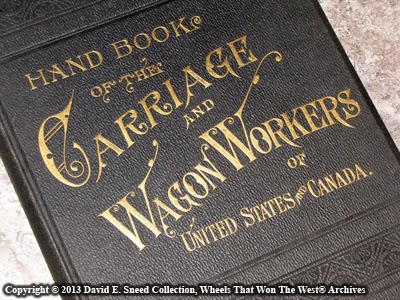From the seemingly simple to the clearly complex, these identity-related questions can also be the most difficult to answer. Much of the reason lies in the size of America's early transportation industry. There were literally thousands of different types, sizes, and styles of wagons produced by tens of thousands of horse-drawn vehicle makers in the U.S. This isn't just an off-the-cuff comment with no documentation to back it up In fact, our archives contain the names of nearly 40,000 makers. Reinforcing that figure, several years ago, we were the first to discover an 1887 report from Clement Studebaker stating that there were at least 80,000 carriage and wagon builders in the U.S. at that time.
Fortunately, the predominant number of surviving wagons can often be narrowed down to less than two hundred makers who dominated the distribution channels. That said, each of these major wagon makers can have dozens - if not hundreds - of variations in construction designs over the course of the company's lifespan. That's where it becomes important to have access to original literature from as many companies and as many different parts of a company's tenure as possible. In a nutshell, that's exactly what we've been collecting for the last two decades as we've built a large compilation of primary source materials for our archives. It's allowed us to consistently review individual vehicles with greater clarity and assurance while providing owners of these vehicles with clearer provenance and stronger documentation.


Along that line of thought, a few years ago, we worked with Doug Hansen to track down more details on a specific set of wheels. At the time, Hansen Wheel and Wagon Shop was working on a museum restoration of an early Fish Bros. wagon that had lost almost all of its original paint. While Fish Bros. wagons (both Racine, Wisconsin and Clinton, Iowa) carried an extraordinary reputation during the 1800s and early 1900s, there are few survivors today. Our archives were called in to help date the vehicle as well as determine whether the gear was original to the box. We were also asked to confirm original striping and logo details. The process involved considerable research within original pieces in our collection. With the earliest Fish Bros. material in the 'Wheels' archives being published in 1875, we were confident we could assist. Ultimately, the wagon was dated to just after the turn of the 20th century. Equally important, we were able to supply the craftsmen at Hansen Wheel and Wagon Shop with detailed imagery showing specific placement of striping in virtually all areas of the box and gear. We were also privileged to provide exclusive, original period artwork of the correct jumping fish logo for the box side.
..

It was a success story for all involved but the primary point I wanted to share is that it could not have happened without the original company literature and sufficient preserved imagery. So, where does that leave a person who doesn't have access to those materials? Fortunately, we're far from the end of the identification story. If an individual is truly committed to learning as much as possible from a vehicle, the piece will have a story to tell. It will talk to you. All we have to do - is Listen. With that as the backdrop, we'll continue this blog next week as we share more details on identification of vintage vehicle makers.
